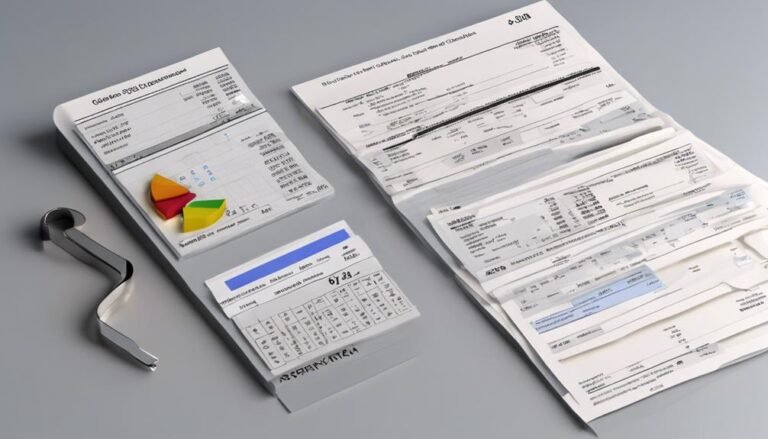What Is a Bank Identification Number (BIN), and How Does It Work?
Bank Identification Numbers (BINs) are vital in payment card transactions, acting as unique identifiers to validate card details and prevent fraud. The BIN structure identifies the card brand, type, and issuing bank, aiding in accurate transaction routing. Merchants utilize BINs for efficient evaluation and risk assessment in payment processes. For international transactions, the Bank Identification Code (BIC) guarantees secure cross-border transfers and global bank recognition. BINs also play an important role in fraud prevention by strengthening transaction security and analyzing data for potential risks. BIN technology advancements continuously enhance transaction efficiency and security measures.
Key Takeaways
- BIN is a unique 6-digit number identifying the bank and card type.
- It aids in routing transactions accurately to the issuing bank.
- BIN validation ensures card information accuracy and reduces fraud.
- Advanced BIN technology enhances transaction security and efficiency.
- Merchants use BINs to verify card information and prevent fraudulent transactions.
BIN Definition and Importance
Certainly, the Bank Identification Number (BIN) plays an essential role in the domain of payment card transactions, serving as a key component in identifying the issuing financial institution and safeguarding against fraudulent activities.
BIN validation is a significant process that guarantees the accuracy of card information and aids in reducing fraudulent transactions. With BIN technology advancements, including sophisticated databases and online checkers, the validation process has become more efficient and effective.
These advancements not only help in confirming card validity but also assist in reducing payment processing errors and evaluating transaction risks. By leveraging BIN technology advancements, merchants can enhance their security measures and provide a more secure payment environment for customers, ultimately leading to a decrease in fraudulent activities.
BIN Structure and Significance
What sets apart the Bank Identification Number (BIN) regarding its structure and significance within payment card transactions? The BIN identification plays an essential role in recognizing the issuer and facilitating transaction processing. Here are four key aspects highlighting the structure and significance of BINs:
- Structure Clarity: The structured format of the BIN aids in identifying the card brand, type, and the issuing bank's country efficiently.
- Issuer Recognition: The issuer identification number (IIN) within the BIN enables merchants to recognize the specific financial institution behind the payment card.
- Transaction Routing: BINs assist in accurately routing transactions by providing essential information about the card and its issuer.
- Fraud Detection: The BIN's significance extends to fraud prevention by allowing for the assessment of transaction risks based on issuer details.
BIN Usage for Merchants
The utilization of Bank Identification Numbers (BINs) by merchants is essential for efficiently evaluating payment card transactions and ensuring secure financial interactions. BINs allow for effective transaction monitoring, enabling merchants to assess the risk associated with each transaction.
By verifying the issuing banks through BINs, merchants can enhance security measures and detect potential fraudulent activities promptly. BIN databases and online checkers play a vital role in validating card information, reducing errors in payment processing, and aiding in risk assessment.
Through the systematic use of BINs, merchants can streamline their payment processes, minimize risks related to fraudulent transactions, and uphold the integrity of their financial transactions.
BIC in International Transactions
In the domain of global financial transactions, the Bank Identification Code (BIC) plays a pivotal role in identifying banks or non-financial institutions involved in international exchanges. The BIC verification process guarantees accurate routing and successful completion of cross-border transactions.
Here are four key aspects highlighting the significance of BIC in international transactions:
- Global Recognition: BIC enables worldwide recognition of financial institutions, facilitating smooth international payments.
- SWIFT Connectivity: BIC, often synonymous with SWIFT code, enhances connectivity for secure and efficient fund transfers.
- Transaction Accuracy: BIC verification ensures the precision of recipient bank details, minimizing errors in international transfers.
- BIN Routing Efficiency: BIC integration with BIN routing enhances transaction efficiency, reducing processing times and costs associated with cross-border payments.
BIN Role in Fraud Prevention
Playing a pivotal role in safeguarding financial transactions, the Bank Identification Number (BIN) is instrumental in fortifying fraud prevention measures within the payment card industry.
Through sophisticated data analysis, BINs aid in enhancing transaction security by enabling the identification of high-risk transactions.
By evaluating BIN data in e-commerce platforms, businesses can effectively detect potential fraud attempts and strengthen their payment security protocols. This proactive approach allows for the quick recognition of suspicious activities, reducing the likelihood of fraudulent transactions.
Additionally, BIN data analysis plays an essential role in the continuous improvement of fraud detection systems, ensuring that transaction security remains a top priority for financial institutions and merchants alike.
Conclusion
In summary, Bank Identification Numbers (BINs) serve as essential identifiers in payment card transactions. They facilitate efficient routing and validation processes while enhancing fraud prevention measures.
As the financial landscape continues to evolve, the structured format and evolving nature of BIN systems play a pivotal role in safeguarding financial transactions.
As the adage goes, 'knowledge is power', understanding the intricacies of BINs is vital for maneuvering the complexities of modern financial operations.







